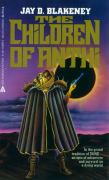 Requiem for Anthi, Jay D Blakeney (1990)
Requiem for Anthi, Jay D Blakeney (1990)
Review by Ian Sales
Five years after The Children of Anthi (see here), Jay D Blakeney returned to the world of Ruantl with a sequel. There was nothing in that first novel which required another book and indeed while Requiem for Anthi does reveal more of the world, its plot is a follow-on rather than a consequence. As Requiem for Anthi opens, civil war among the Tlar houses rages across Ruantl. During the events of The Children of Anthi, Omari/Asan had switched off Anthi and now the lack of the life-support computer has very much worsened the situation of the Tlar’n – their capital city, Altian, is mostly in ruins, they have no electricity or working technological devices, and food is in short supply.
Asan’s putative mate, Aural, is now his enemy and she has allied herself with the Galactic Space Institute. She invites them to the world to help her, but the GSI, of course, wants the mineral wealth of Ruantl for itself and plans to subdue the locals and take control of the entire planet. The first hurdle they must overcome is Asan. Which proves surprisingly easy – Asan continues to be as ineffective a protagonist in Requiem for Anthi as he was in The Children of Anthi. In short order, he is a prisoner on a GSI destroyer, tortured for information while they are en route to Central. Also captured was Zaula, the mate of the Tlar’n ruler Hihuan who Asan killed at the end of the earlier book. She has no psychic powers – ie, rings – to speak of, is smaller than is typical for Tlar’n, but very beautiful – and, of course, Asan responds to her vulnerability and beauty. This is in contrast to Aural, who is also very beautiful – although similar in stature to Asan; but Aural is also powerful and arrogant and ambitious.
The GSI destroyer, however, is waylaid by pirates before it can reach Central. And it transpires that these pirates are in the pay of galactic gang lord Martok. Who employed the vat-born boy, Tobei, who became Blaise Omari and was later transformed into Asan. But Tobei was not willingly let go by Martok, who has hunted him ever since. But even the transformation to a Tlartantlan proves no disguise, as a “thwart” had been placed in Tobei’s subconscious and this is detectable. So Asan comes clean as to his real identity and attempts to save his skin by promising the mineral riches of Ruantl to Martok. (While privately he’s determined to save the planet for the Tlar and Bban, he has so little effect on events that he can only swap one invader for another.)
Then an old friend from Asan’s days as Tobei – who, of course, believes that Asan was Tobei (he was, but it’s still believed a little too readily) – helps Asan and Zaula escape Martok. Asan has learnt more of his past and that of the Tlartantlans, and he has determined on a course of action that will save Ruantl from the depredations of the GSI or Martok: he will call the Merderai. In The Children of Anthi, “Merderai” was an invented swear-word. But it actually proves to be the name of Asan’s personal army from the days of Tlartantla. It proved so effective a force that, like King Arthur’s fabled knights, it was hidden away sleeping until needed again. There are also hints that it was too effective and instrumental in the destruction of the Tlartantlan empire…
Blakeney hands Asan his deus ex machina on a platter, then whips it away… only for it to do the necessary in the last few pages. In that respect, Requiem for Anthi‘s plot is much like The Children of Anthi‘s. And Asan is remains mostly ineffective, even though he is the protagonist and saves the day, in both books. While much of the second book’s story takes place off Ruantl, Blakeney does reveal more of the world’s and its peoples’ history. Again, it’s there, in the world-building, where the Anthi books “arouse interest” (as the SF Encyclopedia has it). Asan, the protagonist, is a cliché, the gutter-rat made good, who learns nobility when a noble purpose is thrust upon him. He’s a staple of science fiction – as are the chief female characters, Aural and Zaula, both of whom harken back to the princesses of Barsoom. The secret behind Ruantl, and its relationship with Tlartantla, provides an interesting twist, but the two books rely a little too heavily on science fiction’s inexplicable liking for feudalism, and such stories’ reliance on hand-wavy science and technology, to stand out much above other similar midlist sf novels.
Amusingly, one of the more annoying archaisms in The Children of Anthi was the use of “thou” and “thee” in formal speech. Someone must have told Blakeney she had this back-to-front, because Asan remarks to Zaula at one point:
“Did you know, Zaula, that in the old days of human history they considered ‘thou’ a familiar usage and ‘you’ the formal one? Just the reverse of the Tlar way.” (p 120)

 The Children of Anthi, Jay D Blakeney (1985)
The Children of Anthi, Jay D Blakeney (1985)